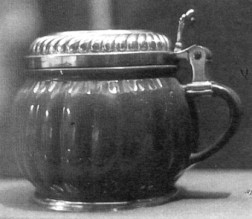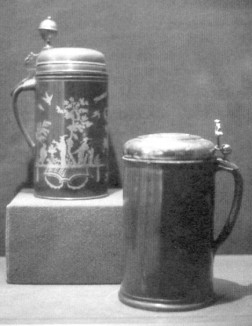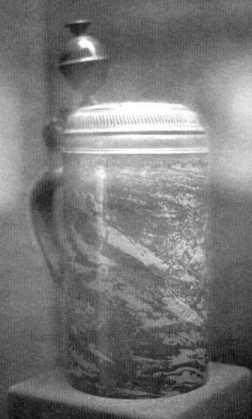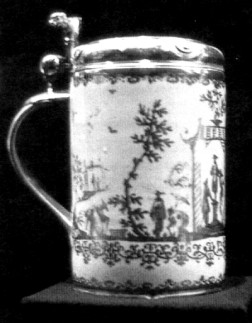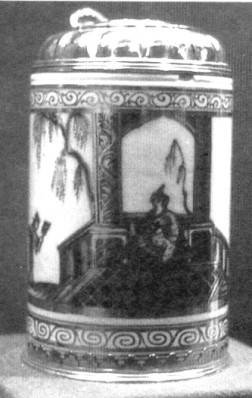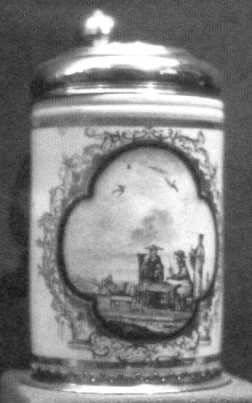|
|
||||||||||||
|
|
||||||||||||
|
This is the second of three
articles which appeared in Prosit from Dec. 1990 to June 1991.
|
||||||||||||
|
Part 2. German Porcelain Steins of the 18th Century: Meissen Following the general description of the George R. Gardiner Museum of Ceramic Art, Toronto, Canada, this and the following parts will comment on the porcelain steins and tankards displayed on the upper floor of the Museum. We will discuss Meissen in this installment, and finish off the series with Vienna and Ludwigsburg. When I visited the Museum after the Dearborn, Michigan, convention in July 1989, I was able to find eleven steins originating from three different factories in German-speaking countries: Meissen (East Germany), Vienna (Austria) and Ludwigsburg (West Germany). Seven of the eleven steins were made at Meissen; three were Vienna porcelain; the ducal porcelain factory at Ludwigsburg was represented by only one stein. The order of this enumeration does not only correspond to the ranking of each factory's importance and fame, but also the age of the eleven steins: The Meissen steins are the oldest ones and the Ludwigsburg stein is the newest. For the definition of these drinking vessels one finds the words "mug" and "stein" or "tankard." The mug is one of the oldest vessel shapes in the history of humanity. A large number of different types of mugs exist; by convention a mug need only have a handle, but not a spout. A special form of mug evolved in the late renaissance: the stein, produced in a variety of materials. The "Wörterbuch der Kunst" (Dictionary of Art) (ref. 2), gives the following definition of a stein: "...a drinking vessel with cylindrical or bulbous shape, made of glass, ceramic or pewter, that usually has a lid; its pedestal base may be separated from its body by a hollow groove." [Editorial note: In the United States, the definition of "stein" as accepted by SCI members, is that a stein is a drinking vessel with a lid and a handle. Neither shape nor decoration enter this definition, although there are size (volume) limits.]Sometimes - I would even say in most cases - the steins are beautifully decorated with pictures or designs, which help us to classify and identify factories, artists, painters, designers and periods of production. During the 17th century these steins became very popular as the vessels of choice for drinking beer or spiced wine. During that century, stoneware and faience were the major materials from which the steins were made. Since European manufacturers did not discover how to make porcelain until the early 18th century, we cannot expect to find any 17th century porcelain steins! Porcelain, its Origin and Characteristics The term "porcelain" comes from the Italian word "porcellana," a word meaning "cowrie shell," used in its popular definition because the inside of this shell looks like Chinese porcelain. The Latin origin of the word is "Porcellus," meaning "little pig." The main ingredients of porcelain are kaolin and feldspar. Kaolin is a fine white refractory clay that remains white after firing; it is also called "china clay." Feldspar, or feldspatic rock, fuses at a sufficiently high temperature (ca. 1450°C) into a kind of natural glass. It is an essential constituent of most true porcelains. The distinction between hard-paste (real porcelain) and soft-paste porcelain is based on the difference in constituents and consequent firing temperatures. Soft-paste porcelain is made by substituting a powdered glass for the feldspar of true porcelain: It can then be fired (and vitrified) at ca. 1200°C. The discovery of porcelain is one of the greatest achievements of China. It dates back to the T'ang period (A.D. 618-906). In China, porcelain, even when found in its highest perfection, is generally a soft-paste porcelain - which attained its greatest importance and world influence when it was decorated in cobalt blue under-glaze. This method of decoration cannot be dated exactly, but we know it began early in the 14th century. Naturally, Chinese porcelain was also exported; the blue and white ware was made exclusively for the export market because the Chinese people didn't like the combination of colors. However, only a few items reached Europe before the 16th century. There was an increase in imports into Europe starting in 1520, and particularly at that time the Portugese were the principal importers. When the big Eastern influence began in Europe starting in the early 17th century, imports of porcelain really skyrocketed, since these wares became favorite collector's items, especially with royalty and the aristocracy.
Italy attempted to produce imitations of imported Chinese soft-paste porcelain towards the end of the 16th century. The number of these unsuccessful attempts kept increasing because of the 17th century vogue - and demand - for Chinese wares. Similarly, experiments to make real porcelain were carried out in the French factories of Rouen and Saint-Cloud, but they produced only a mixed material which fell between glass and clay-based ceramics. These attempts are considered to be the beginning of French manufacture of soft-paste porcelain. The "real," or hard-paste, porcelain, based on oriental examples, was finally produced in Europe in the early 18th century. In 1709, in the German city of Meissen, the alchemist Johann Friedrich Boettger (ref. 3) who had been engaged by Augustus II to discover a way to create gold, found the secret of, and was able to produce, the first real European hard-paste porcelain! However, before he unlocked the secret of the "mystery" for making white porcelain, he developed the formula for the fine red stoneware that is sometimes called Boettger-porcelain, although that is not a correct description. The Ceramic Museum in Mettlach has some stoneware pieces of the Boettger period in its permanent exhibit, and I am sure that some of our readers saw and admired these very rare and precious items when they visited Schloss Ziegelberg. The first European porcelain factory was founded in 1710 in Meissen, and Governor Augustus II proclaimed publicly that he would accord a privilege of exclusivity to this factory. For over 150 years the manufacture of porcelain was carried out in the Albrechtsburg, the landmark of the city. This factory can well be considered the source of all future European porcelain. Boettger himself directed the factory between 1710 and 1719. For this reason, items produced during this period are called "Boettger-porcelain." In addition to the white porcelain, Meissen continued producing the red stoneware until 1719, the year of Boettger's death. Stoneware of the Boettger Period The rapidly increasing production of white porcelain ran parallel to that of red stoneware. Four of the seven Meissen steins on display (figs. 6-8) are made of this stoneware, a material that also has Chinese prototypes. These were fired at over 1300°C, so that the resulting vitrification made the items impermeable to liquids; it also imparted a great hardness and made in unnecessary to glaze the surface. The body can range in color from brownish-red to dark brown, even almost black. Causes for the different colors are the percentage of iron in the clay and variations in the firing temperature. Another characteristic of red stoneware is that it is not translucent because of the lower quantities of feldspar added to the clay mixture. Although decorative glazes were not necessary, different decorating methods were developed: The simplest was to polish the body, so that the surface became very shiny and brilliant, a characteristic appearance. Figures 6 and 7 show two typical examples; the stein in fig. 6 was manufactured during the first five years of the factory's operation, 1710-1714, while the one on the left in fig. 7 was manufactured during the last five years of Boettger's directorship, 1715-1719. Note that this latter stein has gold painting on the polished surface. More difficult than polishing and painting were the incised or engraved designs. The most popular motifs were shields and heraldic coats-of-arms. Another type of decoration, found occasionally, is "marbled" stoneware. As it was difficult to maintain a constant firing temperature in the "new" high-temperature furnaces, different shades of brown, from reddish to almost black, resulted; polishing the body to eliminate these off-color shades brought out the marbled surface. After some of these marbled steins were produced by accident, attempts were made to purposely obtain this effect: Boettger used different colored clays, but he was only successful when firing at low temperatures. However, this marbled stoneware, also called "jasper ware," was discontinued at Meissen after 1713. The stein illustrated in fig. 8 combines an incised design and a marbled body. In addition to the coat-of-arms and the inscription, "Semper Idem" ("Always the Same"), there is also the date, 1727, indicating that the decoration was added a number of years after the production of the stein. At the end of the first period, relief decorations and lacquer or gold painting were preferred. Porcelain of the Boettger Period The early Boettger porcelain was not very translucent. Its color has a smoky appearance, and can on occasion even be a creamy yellow. The body was first fired to biscuit (bisque) at a not-too-high temperature, the decorative glaze then being fired on afterwards in a very hot kiln. Characteristically, the decoration consisted of applied ornaments; a limited range of enamel colors was employed. The Gardiner Museum has some wonderful examples from this first period of the Meissen factory, but not a single one is a beer stein (see figure 2 in the first installment of this series, left side). The Second, "Pictorial", Period at Meissen The three Meissen steins on display (you can see two of them in the above-referenced figure 2) date back to the second period of the factory, 1720-1731, called the "pictorial period". The principal personage of that period was the painter Johann Gregor Hoeroldt (1696-1775), who reformed and improved the painted decorations. During this era Meissen received not only an artistic impetus, but an important economic boost as well. As was the case with faience, porcelain also was frequently decorated by Hausmaler, people who purchased undecorated ware from the factory, then painted them at home or in their own workshops. The stein shown in fig. 9 was manufactured in 1720, but was decorated in 1725 in Augsburg by an independent artist: the stein shows a Chinese scene in gold. The very ornate silver mounting was made by the Augsburg artist J. E. Hengler. This ends our discussion of Meissen steins in the Gardiner Collection. Part 3 will deal with the Vienna and Ludwigsburg factories. References (reference are numbered sequentially through all three articles):
|
Continue your reading by following either of these links:
 ~The George R.
Gardiner Museum of Ceramic Art~
~The George R.
Gardiner Museum of Ceramic Art~